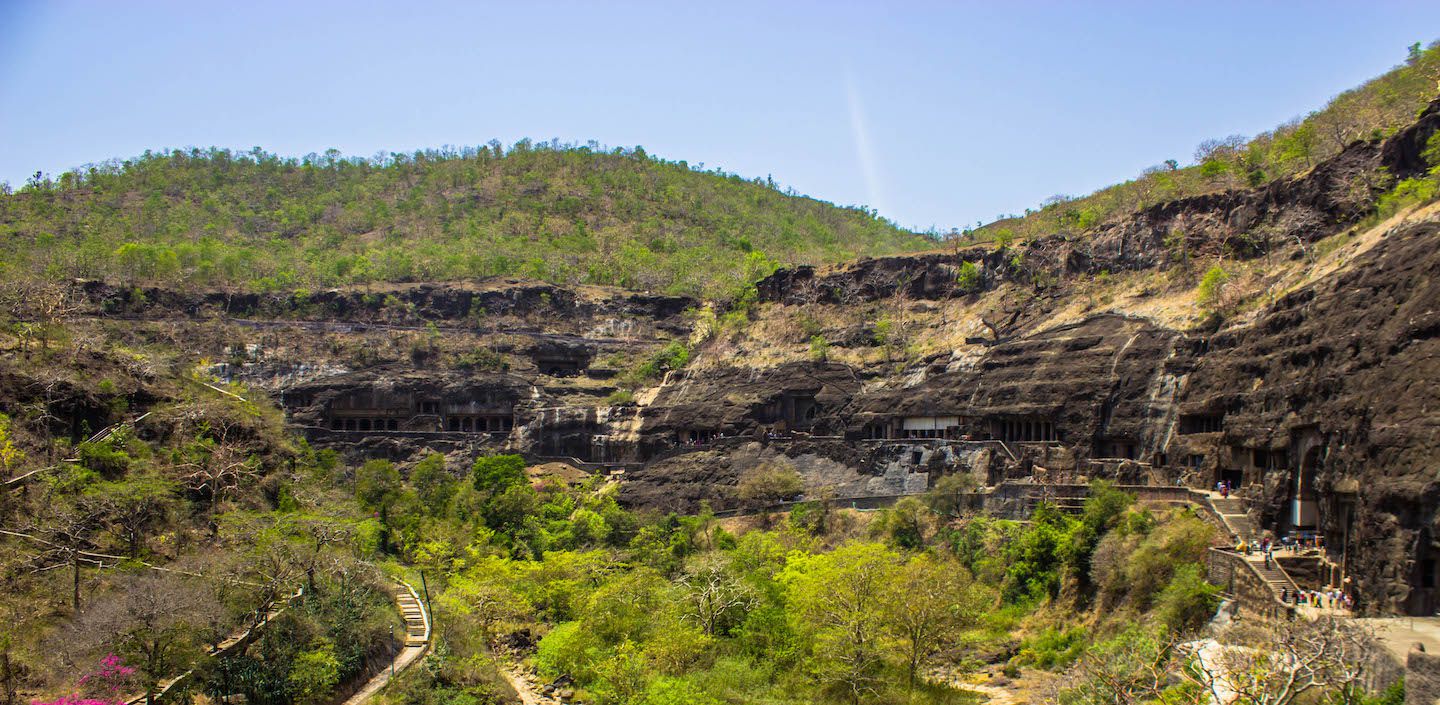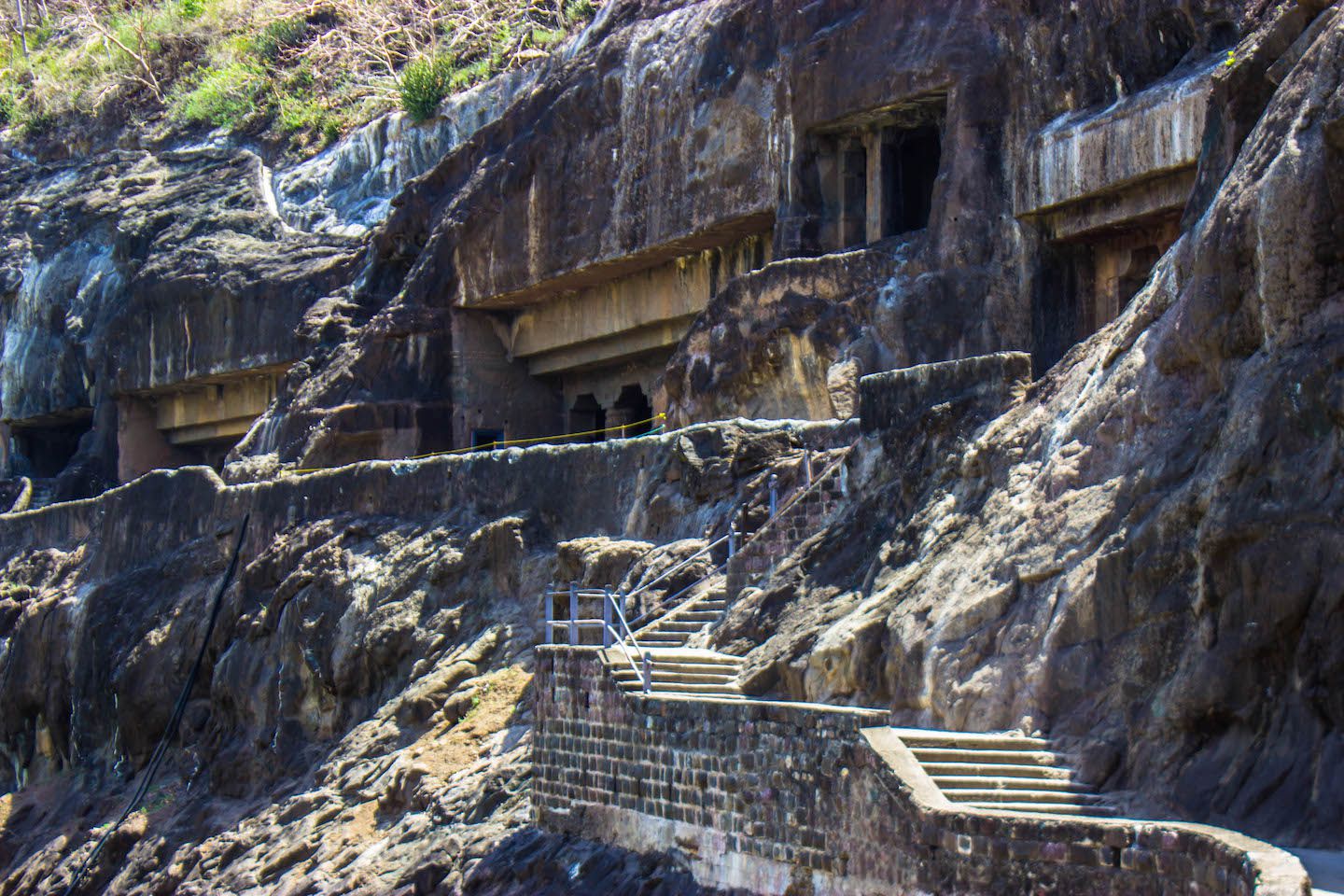After a short stop in Mumbai, we took a side trip to the old Mughal capital of Aurangabad, still in Maharashtra state. The main draw here wasn’t the actual city itself, but the nearby ancient Ajanta and Ellora caves.
We decided to visit the Ajanta Caves first (as it was closed the next day on Mondays) and go for Ellora the day after, giving us plenty of time to enjoy both caves. To get to the Ajanta Caves, we took a three hour long local bus that departed from the city instead of a private car. It was our first long distance local bus in India since we’ve been exclusively taking trains, and it wasn’t so bad. We were dropped off right outside the archaeological park. With tickets in hand, we walked up the steep hill in the direction of the caves.

The 29 caves cut into solid rock date back to the 2nd century BCE and are among the first monastic structures built in India. They served as homes, schools and temples for the hundreds of monks who lived there during its prime time. Covering the outer wall of a horseshoe bend of the Waghur river, the Buddhist caves of Ajanta resembled temple façades, with the rest of the temple hidden in the rock wall.

Each of the caves was different from the others in architectural and aesthetical aspects – the layouts, structures, paintings and sculptures varied from cave to cave. Some of the caves were simple and consisted of a single square room with a Buddha statue carved right across the entrace. Others were more elaborate with columns, smaller rooms on either side, as well as ancient paintings covering most of the walls.

We didn’t visit all 29 caves, but we went in and out as we wished, likely visiting half of them in total. The ones we did see showed us some of the finest surviving examples of India art. Our favorites were, funnily enough, caves number one and twenty nine – the first and last.

The first cave had impressive frescoes adorning its walls and showed great artistic excellence and fine execution in depicting Buddhist tales. It surprised me how well preserved they were. The caves were isolated from humanity for hundreds of years until they were rediscovered in 1819 by the British. Despite looking extremely old – even to our untrained eyes – they were very colourful and detailed.

The last cave was memorable for its complex architectured and embelished prayer hall. The many carved columns rose to support the adorned ceiling that carried many detailed sculptures. In the back end of the hall, a finely crafted stupa protected the Buddha image.

Beyond the stupa and the columns, on the walls of the cave, hundreds of small sculptures seemed to carefully watch your every step inside this holy place. All of these features certainly made cave 29 the most photogenic one.

To be honest, we were relieved our tour through Ajanta caves was over at this point. The weather had gotten very hot by late April. As you can imagine, caves don’t have the best ventilation. Ironically though, it was the coolest inside the shady caves as compared to the sun beating down us outside. With no shade and not a cloud in the sky, it was impossible to walk outside in the archeological park for more than a few minutes. We hopped into the caves to see the ancient art as much as to attempt to cool down. Except it wasn’t really cool, because it was still low 30s Celsius… but that was better than low 40s Celsius outside.

The ride back to Aurangabad wasn’t the best. We felt like canned sardines crammed into a metal can that was being cooked under the 40 degrees Celsius heat. Adding that to the restless 13h train ride from Mumbai the night before, the hour we spent finding a decent hotel early this morning, the three hour bus ride to Ajanta and the few hours wandering around the cave, we just wanted a nice bed and a day of rest.
Taking the next day off, we skipped the Ellora caves entirely. Would it have been nice to see the Ellora caves? Probably. Do we regret not going the next morning? Not really. Even though Ellora had not only Buddhist, but also Jain and Hindu art, we had a good grasp of what it would present to us and decided to leave it at that. We can’t always hit them all, especially in a place as large and diverse as India. Another night train back to Mumbai, and we were flying for the first time in India down to the southern state of Kerala.
For more pictures from Ajanta caves, please visit the gallery!

